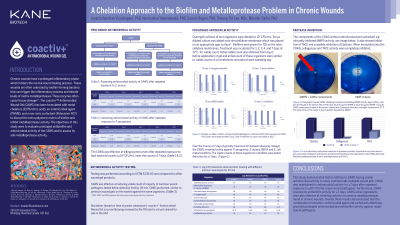Laboratory Research
(LR-054) A Chelation Approach to the Biofilm and Metalloprotease Problem in Chronic Wounds
Friday, April 28, 2023
7:15 PM - 8:30 PM East Coast USA Time

Introduction: Chronic wounds have a prolonged inflammatory phase which hinders the normal wound healing process. These wounds are often colonized by biofilm forming bacteria that can trigger the inflammatory process and elevate levels of matrix metalloproteases (MMPs). A novel wound hydrogel (NWG) has been formulated with metal chelators, an antimicrobial agent, and a non-ionic surfactant to disrupt the polymeric matrix of biofilm and to enhance inactivation of biofilm embedded microorganisms as well as to inhibit metalloprotease activity. The objectives of this study were to evaluate prolonged activity of the NWG against bacteria in both planktonic and biofilm phenotypes and assess anti-metalloprotease activity.
Methods: The efficacy of the NWG over prolonged periods of time was tested in vitro using the ASTM E2149 antimicrobial testing. The efficacy of the NWG was assessed by repeated exposure to fresh bacteria for 7 days. For prolonged activity of NWG against young (24 h) and mature (72h) biofilms of major wound pathogens were tested using the colony biofilm model. Activity of NWG against common wound MMPs was demonstrated using commercial kits.
Results: The NWG maintained its antimicrobial activity against all wound organisms causing > 5 log CFU reduction in viable numbers, when tested using ASTM E2149. No reduction in efficacy was observed after repeated exposure to fresh bacteria, with over 6 log CFU inactivation observed after each repeated exposure for up to 7 days. Exposure of young and mature biofilms of wound organisms to NWG significantly reduced biofilm imbedded organisms (P≤0.05). NWG inhibited common wound MMPs significantly when tested using commercially available kits.
Discussion: These studies demonstrated that the NWG was effective for the maximum application duration at inhibiting biofilm formation and inactivating biofilm embedded microorganisms and metalloproteases. The product contains several divalent ion chelators, which destabilize the biofilm matrix and starve the bacteria of divalent ions needed for basic functioning, furthermore, Metallopreotease divalent ion cofactors are sequestered, resulting in the inactivation of the deleterious enzyme. Overall, the NWG works by combining 3 different modes of action, divalent ion starvation through chelation, surfactant mode of action though the gelling system, and polycation bacterial membrane destabilization through the strong antimicrobial. This triple threat approach should improve the efficacy for a large variety of wound types in a clinical setting.
Methods: The efficacy of the NWG over prolonged periods of time was tested in vitro using the ASTM E2149 antimicrobial testing. The efficacy of the NWG was assessed by repeated exposure to fresh bacteria for 7 days. For prolonged activity of NWG against young (24 h) and mature (72h) biofilms of major wound pathogens were tested using the colony biofilm model. Activity of NWG against common wound MMPs was demonstrated using commercial kits.
Results: The NWG maintained its antimicrobial activity against all wound organisms causing > 5 log CFU reduction in viable numbers, when tested using ASTM E2149. No reduction in efficacy was observed after repeated exposure to fresh bacteria, with over 6 log CFU inactivation observed after each repeated exposure for up to 7 days. Exposure of young and mature biofilms of wound organisms to NWG significantly reduced biofilm imbedded organisms (P≤0.05). NWG inhibited common wound MMPs significantly when tested using commercially available kits.
Discussion: These studies demonstrated that the NWG was effective for the maximum application duration at inhibiting biofilm formation and inactivating biofilm embedded microorganisms and metalloproteases. The product contains several divalent ion chelators, which destabilize the biofilm matrix and starve the bacteria of divalent ions needed for basic functioning, furthermore, Metallopreotease divalent ion cofactors are sequestered, resulting in the inactivation of the deleterious enzyme. Overall, the NWG works by combining 3 different modes of action, divalent ion starvation through chelation, surfactant mode of action though the gelling system, and polycation bacterial membrane destabilization through the strong antimicrobial. This triple threat approach should improve the efficacy for a large variety of wound types in a clinical setting.

.png)